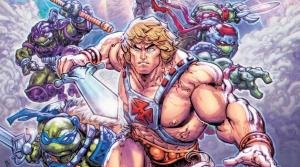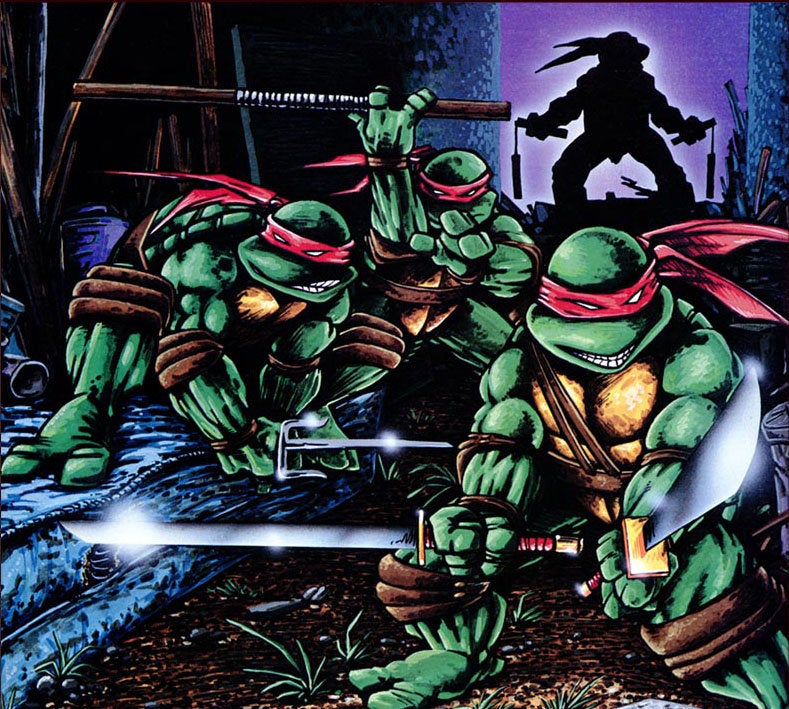
When Teenage Mutant Ninja Turtles opens in theaters this weekend, one thing is almost certainly guaranteed: the film will most definitely be thematically and tonally different than the original Mirage Studios comic book series from the early 1980s. That’s because pretty much every iteration of the TMNT has been vastly different from the original source material.
Videos by ComicBook.com
Created by Kevin Eastman and Peter Laird in 1984, TMNT was never intended to become a global phenomenon. With a print run of just a shade over 3,000 copies, and published in a black and white magazine format, the first issue of the series reads more like a send-up of other, more established comic book characters like Daredevil and the New Mutants. As a result, Eastman and Laird never held back with their series, filling it with gratuitous violence, grotesque imagery and wild and irreverent plot points. Those who first became familiar with the ninja turtles with the rest of the universe in the late 1980s after the launch of the TMNT animated series, will in all likelihood find Eastman and Laird’s comic book characters to be completely unrecognizable. In fact, with the black and white format, the reader can’t even tell which turtle is which unless they were holding a weapon.
And it wasn’t just the 1980s cartoon that was a stark departure from Eastman and Laird’s TMNT. The cartoons, movies and subsequent comics series all offered their own interpretation of Leonardo, Donatello, Raphael and Michelangelo, whether it be by incorporating less violence, or finding other ways to dial down the weirdness that was commonplace during the Eastman and Laird era.
As a nod to the earliest roots of the ninja turtles and a demonstration of just how far the characters have come over the past 30 years, here are eight of the craziest, weirdest and most disturbing moments from Eastman and Laird’s original run, which includes TMNT #1-11 and the four one-shot Micro-Series issues starring the individual turtles.
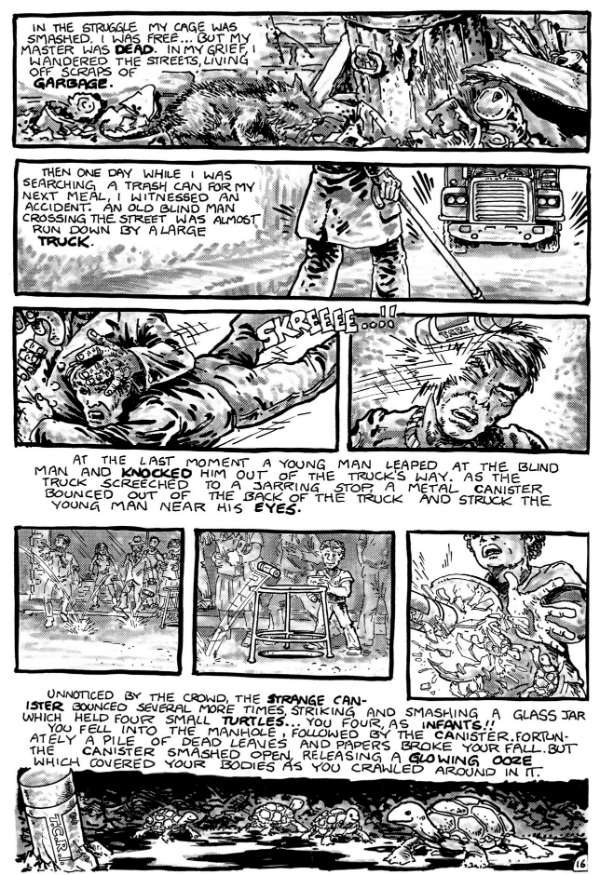
8. So Much Satire, So Much Parody
As the story goes, the first iteration of Eastman and Laird’s TMNT was designed to be a one-off gag which parodied some of the early 1980s most popular comic books: Daredevil, New Mutants, Cerebus and Ronin. And while the inaugural issue of the series features a ton of not-so-thinly veiled references to all of these properties, one sequence in particular is such an over-the-top parody of Daredevil’s origin that it’s amazing that Eastman/Laird and Mirage never got a cease-and-desist letter from Marvel on the matter (perhaps like a tree falling in the woods, the microscopic print run of TMNT #1 kept the comic from registering on the “House of Idea’s” radar).
In the scene, Splinter is recapping his and the turtles’ origins, which begin with a young man (similar to Daredevil’s Matt Murdock) pushing an old blind man out of the way of an oncoming truck (again, like Murdock). Before the truck collides with the young man, it stops short, causing a canister of radioactive waste to escape and bounce down the street. The canister collides with a fishbowl being held by a young boy which contains four turtles. Rather than blinding the young boy (and creating Daredevil), the radioactive canister and the turtles both fall into the sewers, giving birth to the anthropomorphic ninja turtles.
Déjà vu would strike again a few issues later when the hockey mask-wearing, one-man band against crime Casey Jones is introduced. His origins and characterization definitely don’t remind us of Frank Castle, aka the Punisher…
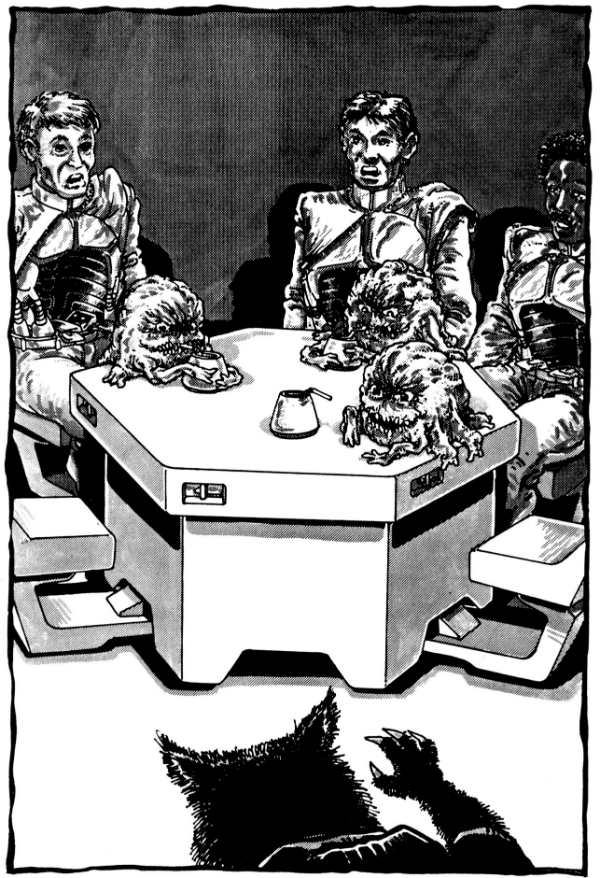
7. Brains for Stomachs
Fans of the original TMNT cartoon, as well as the countless other iterations of the ninja turtles, will probably recognize the character with a talking brain in his stomach as Krang, the supervillain from Dimension X. Sadly, Krang doesn’t actually show up in the Mirage series, and the characters in question actually end up being somewhat benign aliens that are stranded on Earth.
That doesn’t take away from the shock of seeing these absolutely grotesque-looking creatures at the very end of TMNT #3. Even the typically mild-mannered Splinter is freaked out when he walks in on these crawling brains enjoying a tasty beverage. It’s probably unfair for a comic book series that is built around anthropomorphic turtles and rats to cast judgment on aliens that resemble brains, but these Krang wannabes are pretty gross.

6. The Mousers
An invention of the mad scientist Baxter Stockman (who, unlike his TMNT animated series counterpart, never mutates into a fly during the Eastman/Laird run), the Mousers were designed to be high-tech rodent killers until Stockman decides to instead use them to tunnel throughout the city and rob banks (not because he needed the money, but because he could!). However, beyond the nefarious way Stockman uses the Mousers, what’s more unsettling about these contraptions is the graphic way Eastman and Laird depict their exterminating powers.
As Stockman demonstrates his new invention (with April O’Neil as his assistant, not a news reporter) in TMNT #2, a Mouser picks up a rat and gobbles the creature whole, leaving behind a little trail of blood on its mechanical mouth. Eastman and Laird are clearly trying to establish the Mousers as a potential threat to the heroic rodent Splinter, but the violence in the scene still feels a bit out of nowhere and excessive. Plus that poor rat looks pretty terrified in that scene.
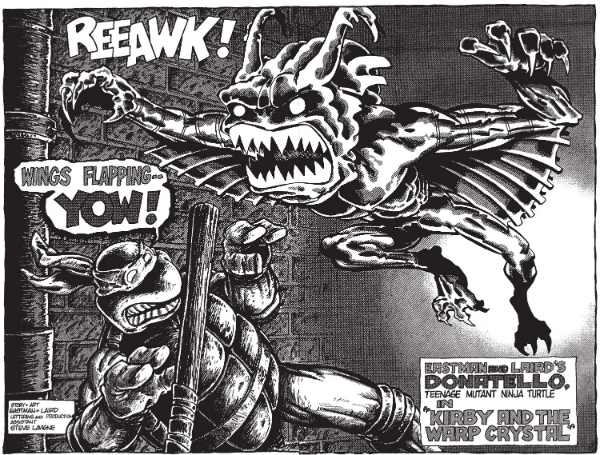
5. Long Live the King
In the TMNT Micro-Series Donatello one-shot, Eastman and Laird pay homage to the “king” of all comic book creators when they introduce Donatello to an enigmatic artist named Kirby King (get it? Instead of “King Kirby?”).
In a neat little nod to Jack Kirby’s famed ability as an artistic world builder and character creator, Donatello first stumbles upon Kirby King when he goes down to fix the water heater in the apartment basement and he’s attacked by a grotesque winged-creature. As Donatello turns the corner of the basement, he sees Kirby penciling away at an illustration before another creature leaps off the page and flies away.
In case anyone still wasn’t catching on to the character reference here, when Kirby meets Donatello, he tells him “I don’t remember drawing you – so you must be real.” Is it possible that the two independent guys in Eastman and Laird were taking a dig at the “Big Two” in how they handled creator rights?
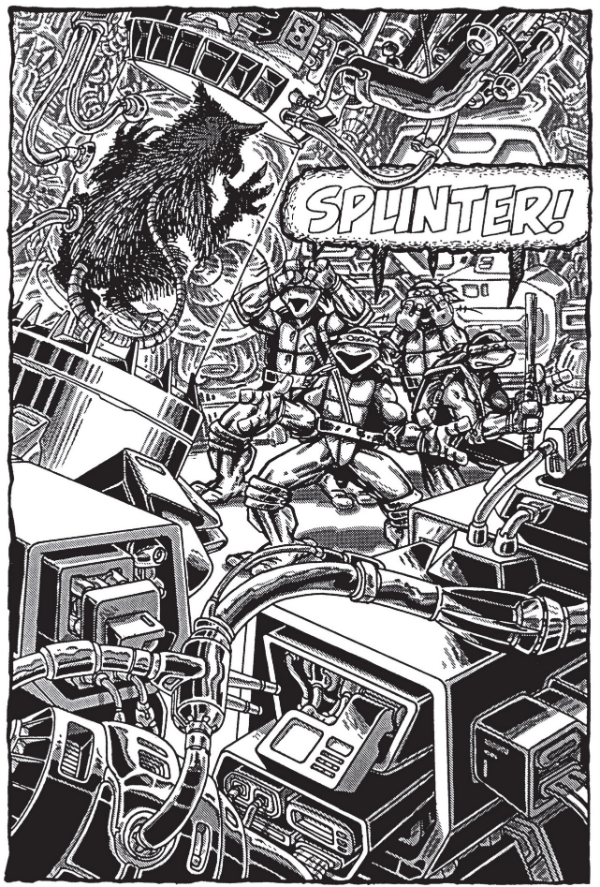
4. Finding Splinter in Suspended Animation
Eastman and Laird’s TMNT is filled with so much disturbing imagery, the reader actually risks becoming numb and disaffected by it the further into the series he gets. However, for those who were starting to emotionally connect to the four main heroes and their mentor Splinter, TMNT #4 delivers an absolutely horrifying visual involving these characters that’s certain to inspire nightmares.
In the story, the turtles are still investigating the recent disappearance of Splinter when they stumble upon the headquarters of TCRI – a company that was somehow involved in the radioactive ooze that mutated the four turtles into adult-sized, green ninjas. The four turtles break into TCRI to get more information and while navigating the building, they stumble upon their mentor inside a giant tube, hooked up to a bunch of machines. Some of the turtles think Splinter’s dead, but Donatello is able to determine that he’s actually in a state of suspended animation.
As it turns out, Splinter is being held there for study by the “brains in stomachs” creatures (see No. 7). That doesn’t erase the horror of seeing a benign character like Splinter being treated like a test tube experiment.

3. Battling the Triceratons
After getting sucked into the aforementioned inter-dimensional portal, the turtles find themselves captured by a race of large, humanoid dinosaur-looking creatures dubbed the Triceratons in TMNT #6. The four turtles are then plopped into the center of a Romanesque arena where they then must do battle against a number of hand-picked Triceratons to the death.
While the level of violence in Eastman and Laird’s universe became old-hat by the time TMNT #6 was published, the ensuing battle is still a bit grotesque, as the turtles, clearly fighting for their lives, slash and stab their way through the competition. When it appears that the Triceratons are still not going to play fair and grant the turtles their freedom, Leonardo holds their esteemed leader hostage at katana-point.
For a bit of icing on this rather twisted cake being offered up in this issue, a commentator, who has been providing play-by-play throughout the turtle/Triceraton battle, feigns shock and disgust in what has happened to his fearless leader, before asking the camera crew for a close-up on all the action. It’s a cute bit of satire on modern entertainment that feels all the more relevant today given our society’s ongoing interest in reality television.

2. Raphael the Sociopath
“Raphael is cool but rude (give me a break),” the theme song to the original TMNT animated series went. But what that catchy tune fails to note is that if somebody pushes the sai-wielding ninja turtle too far – even if it’s one of his own teammates and brothers – he’s liable to fly off the handle and attempt to murder this person.
Yes, before everything was just “Cowabunga” and good times in the Party Wagon, there was an unquestionable dark side to Eastman and Laird’s reptilian creations. Without a doubt, Raphael was generally characterized as the most cantankerous of the bunch, but he really ups the nastiness factor by a couple of notches when he attempts to clobber Michelangelo with a wrench after a sparring match gone horribly wrong in the TMNT Micro-Series Raphael one-shot. The fight is broken up by Leonardo and Raphael is banished from the apartment for a while in order for him to get his head on straight.
The scene is a clear play on Wolverine’s lone-wolf characterization in all of the X-Men books of the early 1980s, but whereas Logan has a mysterious past and is a bit of a square peg being hammered into a round whole of mutant camaraderie in X-Men, there’s really no explanation as to why Raphael would come close to seriously wounding Michelangelo in this comic.

1. Killing Shredder
While fans of the original TMNT animated series remember Shredder as a recurring character and a key antagonist, he was actually killed off rather quickly in the original Eastman/Laird series (before the series became successful and the duo eventually brought him back). But what’s even more shocking about how Shredder was depicted in the series was how he was so violently killed by the book’s titular heroes.
Granted, within the context of the story Eastman and Laird were telling in TMNT #1, Shredder’s death by Leonardo’s katana blade makes sense – they were sent out to confront the villain by their mentor Splinter, who, for all of his sage-like philosophizing, wanted vengeance for the role Shredder played in the death of his own master. So after killing Shredder, Leonardo and the turtles consider everything mission accomplished and move on with their lives.
Except these are the “heroes” in the first issue of their very own series killing an adversary. That’s just a tremendous departure from how other superhero comics were being written up until that point. Plus, the scene serves as another reminder that for anyone who grew up on the TMNT cartoon, these four characters are not the fun-loving, pizza-eating bunch that adorned t-shirts and lunch boxes everywhere in the late 1980s/early 1990s.



